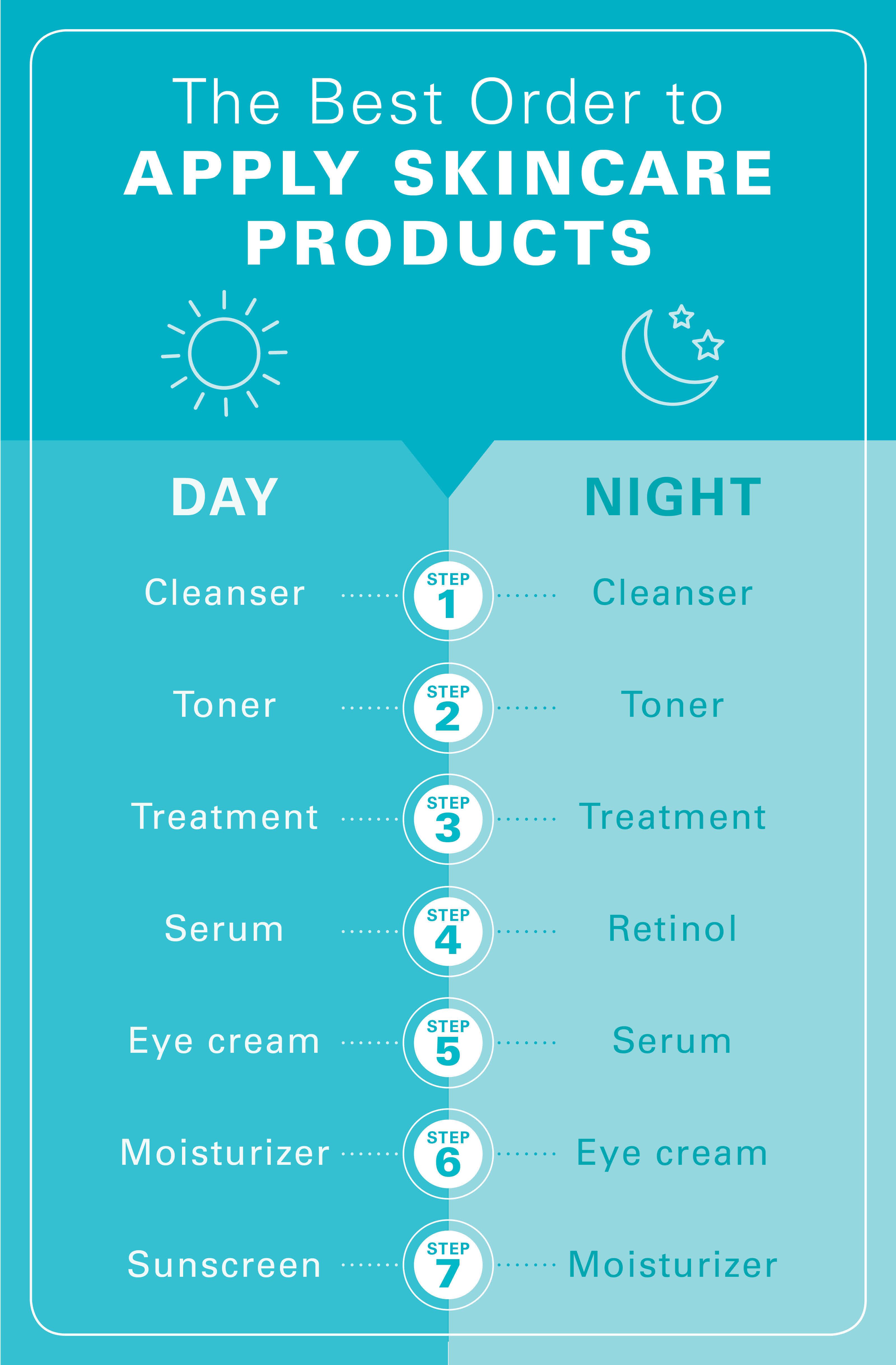There’s a whole world of face washes, anti-aging serums, and moisturisers out there; not to mention retinol and other targeted treatments. So it’s no wonder determining the right skincare routine order can be tricky. And it’s important – layering your products properly can mean the difference between a dull complexion and glowing skin.
So, why does the order of your skincare routine matter? Applying products in the wrong sequence can diminish efficacy and therefore results, whether that’s due to the texture or the ingredients. You could be using all of the latest and greatest formulas, but if you’re not using them correctly, you’re defeating the purpose.
It might be best to start with a simple, no-frills approach before loading up on extras while you get the hang of things. And while adding to your routine can be exciting, make sure you don’t pile on new skincare all at once. This is a recipe for breakouts and can make it difficult to know which products are working and which aren’t.
Ahead, find the best daytime and nighttime dermatologist-approved skincare routine steps, from the basics to the advanced.
Basic skincare routine order
There’s a laundry list of skincare goodies that you can add to your routine and while a multi-step approach has its benefits, it’s not a necessity. In fact, less is often more when it comes to skincare.
If you’re just getting your toes wet in the beauty world or want to minimise your routine, here are basic skincare routine steps to follow in order:
1. Cleanser
2. Moisturiser
3. Sunscreen
“Just keep it simple,” says cosmetic dermatologist Dr Karan Lal. “The goals are just to make sure you’re hydrating your skin, you’re protecting yourself from the sun, and you’re cleansing. That’s all you really need.”
The steps for applying skincare products
If you’re using more than just the basics, it can be difficult to know the correct order for various skincare routine steps. Thankfully, there’s a pretty simple rule when it comes to layering your lotions, serums, and masks.
“The general rule of thumb, just like your clothes, is lighter to heavy,” explains dermatologist Dr Mona Gohara. Thicker or heavier products, like moisturisers and oils, are meant to be protective, Dr Gohara says. Applying those at the end of your routine will help seal in your other steps and keep skin healthy, she notes. Also, applying heavier before lighter will prevent the ingredients in your products from absorbing into the skin properly.

Skincare routine order
1. Cleanser: am and pm
Step one, day and night, should always be cleansing. In the morning, “use a gentle cleanser to get rid of the oil that you accumulated overnight on your face,” Dr Lal explains. Non-foaming or oil-based cleansers are great products to use to gently cleanse and prep skin for the day ahead.
At nighttime, the same concept of gentle cleansing applies to remove “whatever dirt or oils accumulated during the day,” explains Dr Lal. Also, if you wear makeup, try double cleansing at night with a balm or oil to remove makeup before a second wash to truly cleanse the skin. Here’s what to look for in a cleanser based on your skin type.
- Dry/sensitive skin: A creamy, non-foaming, and hydrating face wash with ingredients like hyaluronic acid and ceramides will help cleanse dry, sensitive skin while keeping it hydrated. Look for a fragrance-free, non-comedogenic face wash, says Dr Lal.
- Oily/acne-prone skin: Oily skin types or those that struggle with acne should use a cleanser balanced with hydrating and nourishing ingredients in addition to an active ingredient like salicylic acid or benzoyl peroxide meant to keep acne and oil at bay, dermatologist Dr Nazanin Saedi says.
- Combination skin: Look for a gel or cream-to-foam texture face wash that will cleanse skin of excess dirt, oil, or makeup without stripping the skin of its natural moisture, says dermatologist Dr Marisa K. Garshick.
2. Toner: am and pm
Toners might not be necessary for your routine, but using the right one can help target specific concerns like dullness or dryness, and serve as a great way to prepare your skin for absorbing the rest of your products. Toners are often thin and have a watery texture, meaning you’ll want to apply one right after cleansing, before any thicker or heavier products. Here’s what to look for in a toner based on your skin type.
- Dry/sensitive skin: Skip the actives in your toners and instead opt for formulas that contain moisturising and soothing ingredients like hyaluronic acid and glycerin, says dermatologist Dr Corey L. Hartman. While hydrating toners can be a great way to provide dry skin with an extra dose of moisture, if your skin is too sensitive to tolerate toners, this step is fine to skip.
- Oily/acne-prone skin: Look for exfoliating beta-hydroxy acids (BHAs), alpha-hydroxy acids (AHAs), or poly hydroxy acids (PHAs), like salicylic, glycolic, or lactic acids, to help clear pores and reduce sebum production, says dermatologist Dr Zain Husain.
- Combination skin: If you have combination skin pick a toner that has both hydrating ingredients as well as gentle actives to gently prep your skin for the products to follow, says Dr Husain.
3. Treatment or medication: am and pm
If you use any sort of treatment or prescription topical medication for a specific skin concern like acne or rosacea, you want to apply those early on in your routine for increased absorption.
Things like retinoids, benzoyl peroxide creams, topical antibiotics, or anti-inflammatory creams are “the good stuff. We want those to get absorbed properly,” Dr Lal explains. Listen to your dermatologist regarding what time of day your medicated treatments should be applied.
4. Retinols: pm
Retinols (note: not retinoids, which are prescribed, stronger retinol) should always be applied during your evening skincare routine only, as sunlight will degrade most formulas and these products make your skin more sensitive to the sun, explains Dr Lal.
Like other treatments or medicated products, these should be applied as early as possible in your routine so your skin can soak in all the benefits. Retinols can be safely used on all skin types, and below Dr Lal breaks down how to choose one that will work best for you.
- Dry/sensitive skin: Retinol, as opposed to a stronger formula like a retinoid, “is the best place to start for beginners and/or those with dry [or sensitive] skin,” explains Dr Lal. Use it with a quality moisturiser two to three nights per week before working up to nightly application.
- Oily/acne-prone skin: Those with oily and/or acne-prone skin will benefit from a product containing adapalene, “which is a true retinoid, and is much stronger than retinol,” says Dr Lal.
- Combination skin: Choose a gentle retinol product before working your way up to using a product containing retinaldehyde, “which is stronger than a retinol, but weaker than a retinoid,” explains Dr Lal.
5. Serum: am and pm
Face serums are thinner than a moisturiser or lotion and thicker than a toner, so make sure you sandwich yours in between the two. The best part about serums is that they are highly concentrated formulas meant to treat an array of skin concerns, depending on the ingredients. Serums can be used both morning and night, but some formulas are best suited to one or the other.
Vitamin C and other antioxidant serums should be applied during the daytime, as these formulas help protect your skin from elements like UV rays and pollution. Hydrating serums or reparative serums (like retinol or AHA/BHA-containing serums) are best used at night when your skin naturally seeks to repair itself. Here’s how to choose the best serum for your skin type.
- Dry/sensitive skin: Choose a fragrance-free serum with hydrating and soothing ingredients like hyaluronic acid, niacinamide, vitamin E, and aloe vera, says dermatologist Dr Dianne Davis.
- Oily/acne-prone skin: If you’re not already using a targeted or medicated treatment elsewhere in your routine, look for a serum containing acne and oil-busting ingredients like salicylic acid or retinol to help exfoliate and regulate your skin, says Dr Gohara.
- Combination skin: Serums are all about targeting an area of concern, which often varies among those of us with combination skin. A great ingredient for those seeking to restore balance to their skin is niacinamide, which helps regulate oil protection and maintain overall moisture and hydration, in addition to a whole host of other benefits, says dermatologist Dr Tsippora Shainhouse.
6. Eye cream: pm
Eye creams tend to be more lightweight than your all-over face cream, plus they often contain ingredients meant to target specific concerns, so definitely apply these before a face moisturiser, Dr Lal says.
If you’d like to give your eye area an extra boost of moisture or tackle things like dark circles, wrinkles, or under-eye bags, an eye cream is a great addition to your skincare routine. Apply simple, hydrating formulas during the daytime and reserve your targeted treatments (like those with retinol, or thicker creams) for the evening.
7. Moisturiser: am and pm
Moisturiser, no matter your skin type, is an essential step to healthy skin. Applying the right face moisturiser will help lock in hydration and moisture and support the skin barrier. This step also serves as a way to seal in all of your other products, like toners, treatments, and serums. Here’s how to choose the best moisturiser for your skin type.
- Dry/sensitive skin: Similar to other products, look for a simple formula containing hydrating, moisturising, and nourishing ingredients, says Dr Gohara. A fragrance-free formula and a shorter ingredient list are also important for those with sensitive skin.
- Oily/acne-prone skin: Moisturiser is key, even if you have acne-prone or oily skin. Choose an oil-free, non-comedogenic moisturiser with a lightweight gel formula full of hydrating ingredients to help regulate your skin, says dermatologist Dr Arielle Kauvar.
- Combination skin: Similar to those with oily skin, look for lightweight, simple, hydrating formulas, according to Dr Kauvar.
8. Sunscreen: am
Applying your SPF daily “really isn’t negotiable,” says Dr Gohara. No matter your skin tone or type, or if you’re indoors or outdoors, apply at least SPF 30 every single morning to protect your skin from harmful UV rays. Searching for the best sunscreen? Check out what to look for according to your skin type.
- Dry/sensitive skin: Look for a hydrating sunscreen with skincare ingredients like hyaluronic acid and glycerin, says dermatologist Dr Joshua Zeichner. For those with particularly sensitive skin, mineral sunscreens can be great options, too.
- Oily/acne-prone skin: Try using a mineral sunscreen to avoid triggering any acne breakouts, says dermatologic surgeon Dr Dendy Engelman. There are also lots of mattifying options on the market to avoid a shiny complexion.
- Combination skin: Similar to those with oily skin, look for a lightweight formula. You can also use a powder sunscreen on your shiny areas.
What happens if I apply skincare in the wrong order?
For the most part, applying skincare products out of order doesn’t usually constitute an emergency. However, you may not be getting the most out of your precious products if you layer them incorrectly. And sometimes certain products don’t play well together which can cause irritation, but that has less to do with the order of products and more to do with introducing new products to your routine.
Applying heavier products, like lotions and oils, before lighter products, like serums and toners, may not allow your products (and the active ingredients in those products) to penetrate the skin and fully absorb, according to Dr Gohara. And if this doesn’t happen, you’re not maximising their benefits.
What to do if skin gets irritated
Sometimes we can get a little excited when it comes to trying new skincare. If you happen to get overzealous with the products and ingredients slather on your face, you may experience a bit of irritation. This kind of irritation is known as contact dermatitis, says dermatologist Dr Rajani Katta.
To soothe skin and get rid of irritation, you’ll want to pare down your routine to just the basics and opt for gentle cleansers and moisturisers, Dr Katta explained. As your skin returns to normal, be sure to slowly introduce new products and ingredients to avoid further irritation.









